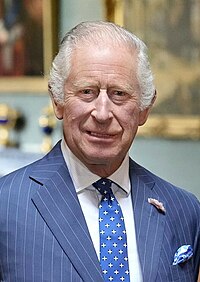
Back النظام الملكي الأسترالي Arabic پاشایەتیی ئوسترالیا CKB Seznam australských panovníků Czech Det australske monarki Danish Monarquía en Australia Spanish پادشاهی استرالیا Persian Monarchie australienne French המלוכה האוסטרלית HE ऑस्ट्रेलियाई राजतंत्र Hindi Kerajaan Australia ID
| King of Australia | |
|---|---|
Federal | |
 | |
| Incumbent | |
 | |
| Charles III since 8 September 2022 | |
| Details | |
| Style | His Majesty |
| Heir apparent | William, Prince of Wales |
| This article is part of a series on the |
| Politics of Australia |
|---|
 |
| Constitution |
|
|
The monarchy of Australia is a key component of Australia's form of government,[1] embodied by the Australian sovereign and head of state. The Australian monarchy is a constitutional one, modelled on the Westminster system of parliamentary government, while incorporating features unique to the constitution of Australia.
The present monarch is King Charles III, who has reigned since 8 September 2022.[a] The monarch is represented at the federal level by the governor-general (currently David Hurley[4]), in accordance with the Australian constitution[5] and letters patent from his mother and predecessor, Queen Elizabeth II.[6] Similarly, in each of the Australian states the monarch is represented by a governor (assisted by a lieutenant-governor), according to the Australia Act and respective letters-patent and state constitutions.[7] The monarch appoints the governor-general on the advice of the prime minister and the state governors on the advice of the respective premiers.[8][9] These are the only mandatory constitutional functions of the monarch of Australia.[10]
Australian constitutional law provides that the person who is monarch of the United Kingdom will also be the monarch of Australia.[11][12] Since the 1940s at the latest, the Australian monarchy has been a distinct office and in that capacity, they act exclusively upon the advice of Australian state and federal ministers. Australia is one of the Commonwealth realms, 15 independent countries that share the same person as monarch and head of state.[13]
- ^ "Australian System of Government". Parliamentary Education Office. 3 November 2023.
Australia is a representative democracy and a constitutional monarchy. It is also a federation of states. Many features of Australia's system of government are based on the Westminster system.
- ^ "The day Queen Elizabeth died: the inside story of her final hours". The Guardian. Retrieved 16 June 2023.
- ^ "Coronation frequently asked questions". www.pmc.gov.au. Australian Department of the Prime Minister and Cabinet. Retrieved 6 November 2023.
- ^ "Governor-General's Commission". Federal Register of Legislation. Commonwealth of Australia Gazette. 2 July 2019. Federal Register id: C2019G00563. Archived from the original on 15 January 2024.
- ^ Constitution (Cth) s 2
- ^ Letters Patent Relating to the Office of Governor‑General of the Commonwealth of Australia, 21 August 2008 "Office of Governor-General of the Commonwealth of Australia – 21/08/2008". Archived from the original on 14 July 2022. Retrieved 8 April 2023.
- ^ Australia Act 1986 (Cth) s 7
- ^ Rhodes, Campbell (30 April 2018). "What Does a State Governor Do?". Museum of Australian Democracy at Old Parliament House. Archived from the original on 5 November 2023.
- ^ "The role of the Governor-General". The Governor-General of the Commonwealth of Australia. Archived from the original on 25 October 2023. Retrieved 5 November 2023.
Under the Australian Constitution, the only action performed by The King is the appointment of the Governor-General (on the advice of the Australian Prime Minister)
- ^ "Infosheet 20 - The Australian System of Government". Parliament of Australia. Retrieved 6 November 2023.
The King's only necessary constitutional function is to appoint the Governor-General, and in doing this the King acts as advised by the Australian Prime Minister. The Constitution gives the King the power to disallow an Australian Act of Parliament, but this has never been done and it is extremely unlikely that it would ever be done.
- ^ Commonwealth of Australia Constitution Act 1900 (Imp) s 2
- ^ Australia's Constitution: With Overview and Notes by the Australian Government Solicitor (PDF). Parliamentary Education Office and Australian Government Solicitor, Canberra. November 2022. p. iii.
The Constitution itself is contained in clause 9 of the British Act. The first eight clauses of the British Act are commonly referred to as the 'covering clauses'. They contain mainly introductory, explanatory and consequential provisions. For example, covering clause 2 provides that references to 'the Queen' (meaning Queen Victoria, who was British sovereign at the time the British Act was enacted) shall include references to Queen Victoria's heirs and successors. Following the death of Queen Elizabeth II in September 2022, references in the Constitution to 'the Queen' now include King Charles III.
- ^ "Realms and Commonwealth". royal.uk. Retrieved 24 December 2023.
Cite error: There are <ref group=lower-alpha> tags or {{efn}} templates on this page, but the references will not show without a {{reflist|group=lower-alpha}} template or {{notelist}} template (see the help page).